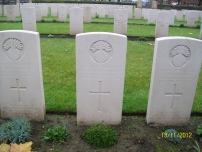| First Name: | John | Last Name: | McDONALD | |
|---|---|---|---|---|
| Date of Death: | 16/11/1915 | Lived/Born In: | Hampstead | |
| Rank: | Bombardier | Unit: | Royal Field Artillery C Battery 79 Brigade | |
| Memorial Site: | ||||
Current Information:Age-18 16 Mackeson Road, Hampstead Strand Military Cemetery, Ploegsteert During the First World War some 800,000 British and Allied men served in the artillery, of whom nearly 50,00 were killed. They were a vital component of the army, used for a number of purposes but essentially to destroy the enemy’s defences before the infantry attacked. A brigade of the Royal Field Artillery, was the equivalent of an infantry battalion with a complement of over 800 officers and men whereas the artillery battery numbered about 200 personnel. Within the ranks there were gunners and bombardiers, drivers, signallers and telephonists. At the beginning of the war when things were much more fluid, artillery batteries could find themselves in the front line of the action but as the war progressed and trench warfare became the norm, the batteries were placed behind the line and in the case of the Royal Garrison Artillery, which employed the big, heavy guns, often many miles back from the line. However this did not mean safety. The enemy would use spotter planes and other methods to determine the positions of the guns and these would then be targeted by their own artillery. When this happened there was little escape for the gunners. They had to keep firing their own guns regardless of what might be happening around them and there were many a direct hit on their emplacements, killing and injuring whole gun crews. Others would act as spotters which meant going forward to the front line and signalling back to the guns necessary changes in target and other vital information. Once in position, artillery brigades tended not to move much so whilst the infantry could be relieved at regular intervals and move back to safer positions, the men of the artillery stayed where they were for much longer periods of time.
79th Brigade of the Royal Field Artillery was attached to 17th Division throughout the war. This division was one of the New Army divisions and arrived in France in July 1917. For the remainder of 1915 and the first part of 1916, 17th Division were holding the line in the southern part of the Ypres salient. Bombardier McDonald |
||||
| « Back to Search Results | ||||
| If you think any of the information shown here is incorrect, Click Here to submit your amends and comments | ||||




